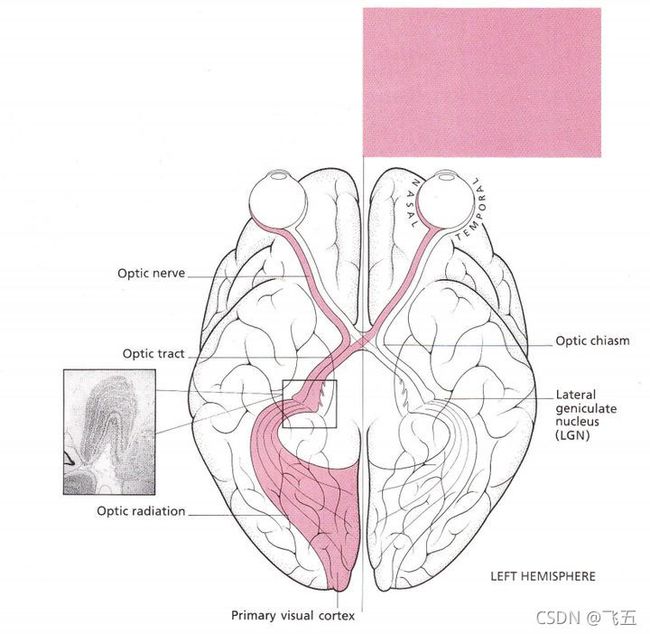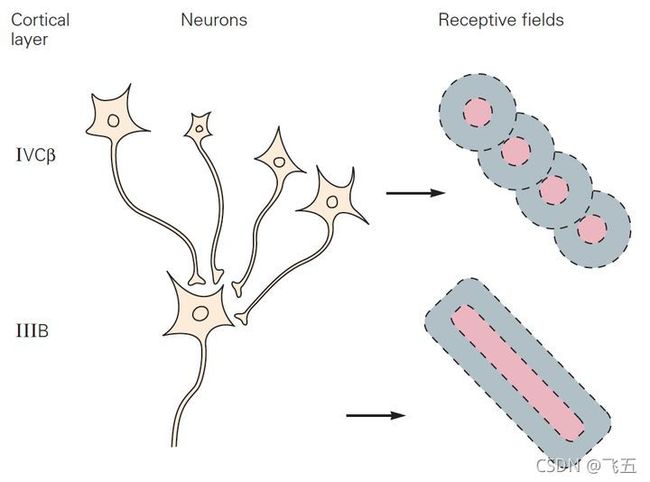【学习笔记】Visual Cortex of Human‘s Brain
Brain of Human
Feature 特征
- nerve center;
- billions of neurons;
- programs responses;
- do things simultaneously.
Division 分区
Cerebrum 大脑
left & right, connected by bundles of nerve fibers
Cerebral Cortex 大脑皮层
outermost layer of cerebrum;
deep folds 褶皱: increase the area of the cerebral cortex, create space in this surface layer for more neurones, so that increase the brain’s processing power
(deepest division is used to identify the lobe 脑叶)
Frontal Lobe 额叶
at the front of the brain, immediately above the eyes
coordinate voluntary movements and speech, memory and emotion, higher cognitive skills, and many aspects of personality
BLUE part
Parietal Lobe 顶叶
at the top of the brain, immediately behind the frontal lobes
integrate sensory signals from the skin, process taste, and process some types of visual information
YELLOW part
Occipital Lobe 枕叶
at the back of the brain, immediately behind the frontal lobes
process visual information and integrate them into complex visual understanding
PINK part
Temporal Lobe 颞叶
on the sides of the brain, at and below the level of the eyes
carry out some visual processing and interpret auditory information
GREEN part
Visual Pathway 视觉通路
graph LR
A(RGC 视网膜神经节细胞)-->B(LGN 丘脑外膝体)--换元-->C(V1 初级视觉皮层)
C-->D(MT, V2, V3)
D--Ventral Pathway 腹侧通路---->E(V4, IT -- 编码物体是什么)
D--Dorsal Pathway 背侧通路---->F(LIP, AIP -- 编码物体怎么运动)
对于视觉的复测通路,传统的观念认为信息自下而上流动的过程(Bottom Up)是一个不断整合信息,逐渐抽象编码直至一个形成一个完整物体的过程。
视网膜上收集到视觉信号,两眼的optic nervers走过类似交叉路口的optic chiasm,然后将信号发到大脑的lateral geniculate nucleus(LGN)的区域中,然后将视觉信号一层层分门别类,整理好后发送到初级视觉皮层(primary visual cortext)
在视觉皮层之后,通路王大脑上方走的分析的是视觉信号所带来的"where"信息:物体位置信息;往下方走的,分析的是关于"what"信息:识别和描述看到的是什么东西。
RGC 视网膜神经节细胞
RGC是视网膜唯一能够产生动作电位的细胞,具有环形感受野。
如果在视野的某个特定位置出现了一束像这样中间亮边缘暗(有的细胞与之相反,倾向于周边亮中间暗的刺激),对应细胞就会发出动作电位。
V1 初级视觉皮层
V1内细胞主要对视野内某个区域某一朝向的边缘信息敏感(Orientation Selectivity),此外V1的一部分细胞也会编码这个边缘的运动方向信息。
具有方向选择性的V1细胞可以进一步分为简单细胞(simple cells)和复杂细胞(complex cells),前者的感受野是中心-边缘式的一根亮条,对超出该范围的刺激无反应(推测其原因是整合了多个LGN细胞的感受野)。
相比之下,复杂细胞对较大区域中的刺均有反应,且知识表现出方向选择性,为表现出对明暗区域间隔的敏感性(ON型刺激和OFF型刺激均能使其兴奋,推测这样的细胞由多个简单细胞的感受野复合而成)。
V2 第二视觉皮层
加工V1皮层处理过的边缘信息的高层次的一些相关关系,类似于处理一个物体的材质信息。
目前研究对于V2性质的理解尚不够深入,虽然对于比较简单的刺激而言,V2的性质和V1类似,但是对于复杂的材质类型编码机制还不够清楚,有待进一步的研究。
V4 第四视觉区域
(为什么不提及V3?————第三视觉区域主要在传递视觉相关信息而非处理。)
V4的编码整合视野内的物体边缘,从而通过V4群体编码可以反映这个物体的完整边缘、形状信息。
IT
以细胞集群的方式编码,对所看到的“特定物体”激活。
(留待补充…)









